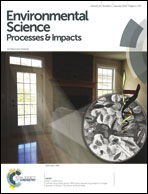A mesocosm study of the effects of wet–dry cycles on nutrient release from constructed wetlands in agricultural landscapes
Abstract
Given the projection that wet–dry periods will be more frequent in the US Midwest, a study was conducted to understand the impact of these hydro-climatic alterations on nutrient dynamics in wetlands constructed on former croplands in the region. Soil cores were collected from two constructed wetlands and a wooded riparian area (surface: 0–20 cm; subsurface: 40–60 cm) downslope from an agricultural field. Cores were either kept moist or subjected to a 5-week drying treatment, after which all cores were flooded for 36 days. Initial nitrate flux was significantly (p < 0.001) higher in the dry than in the moist treatment (44.5 vs. 1.9 mg N m−2 per day), likely due to mineralization of organic matter. The NO3− released was rapidly denitrified (N2O flux: 18.9 mg N m−2 per day), except in the subsurface soil cores in which processing of available N (N2O flux: 0.33 mg N m−2 per day) was limited by low microbial activity (4 times lower CO2 production rate). The dry treatment also resulted in significantly (p < 0.01) higher inorganic P (Pi) flux (3.1 versus 1 mg P m−2 per day in moist cores), with water-extractable soil P being the best predictor (r2: 0.93, p < 0.03) of that flux. Despite a decline in redox potential (as low as −36.4 mv) and progressive increase in pore-water dissolved Fe, no relationship between floodwater Pi and dissolved Fe was observed, suggesting either limited contribution of reductive dissolution to Pi dynamics or rapid adsorption of the Pi released within the cores. Compared to the moist cores, geochemical modeling showed a consistent shift toward greater solubility of the calcium-phosphate minerals controlling pore-water Pi concentration in the dry treatment cores. These results suggest that dissolution of Ca–phosphate minerals could be a key factor controlling Pi mobility in constructed wetlands subjected to wet–dry cycles.


 Please wait while we load your content...
Please wait while we load your content...